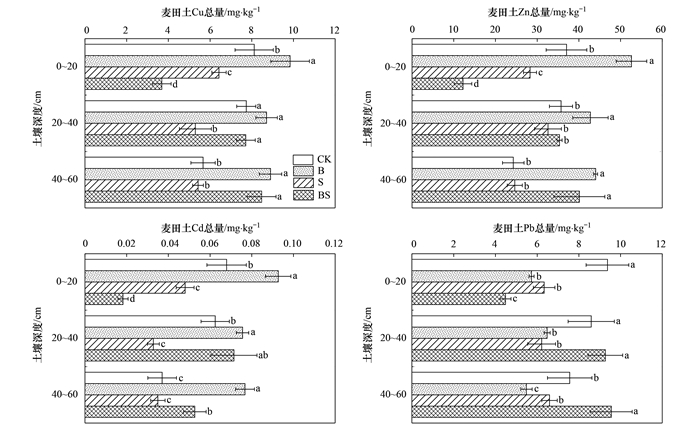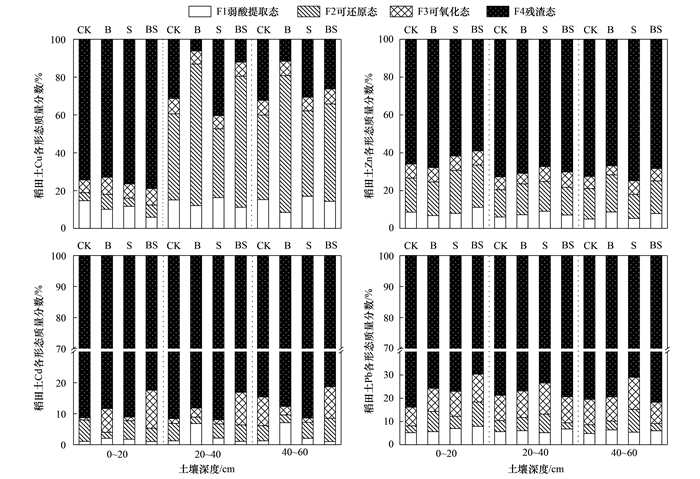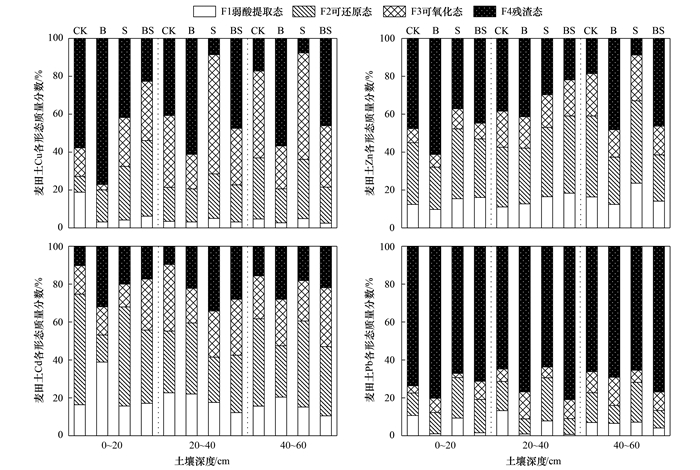2. 南京林业大学南方现代林业协同创新中心, 南京 210037;
3. 中粮肉食(江苏)有限公司, 东台 224200
2. Collaborative Innovation Center of Sustainable Forestry in Southern China of Jiangsu Province, Nanjing Forestry University, Nanjing 210037, China;
3. COFCO Meat(Jiangsu) Co., Ltd., Dongtai 224200, China
江苏省滩涂总面积7 620 km2, 约占全国滩涂总面积的1/4[1].长期围垦而形成的大量农田已成为我国粮食保障的重要后备基地.然而, 作为海陆交汇区域, 土壤中重金属的环境风险备受关注[2~4].例如, 孟庆峰等[5]的研究认为盐城围垦农田土壤重金属含量偏高.姚荣江等[6]的研究显示重金属呈现不断累积的趋势.刘洋等[7]对当地作物籽粒进行测定发现存在重金属超标问题.因此, 降低围垦田重金属环境风险对提升土壤质量, 保障区域粮食安全具有重要意义.
围垦农区分布着众多大规模集约化养猪场, 沼液是其最主要的副产品.沼液富含易利用态氮素和多种生物活性物质[8, 9], 是化学氮肥替代的首选.然而, 有研究表明, 沼液施用使土壤中重金属的环境风险增加.例如, 汤逸帆等[10]的研究表明, 沼液施用5 a后, 稻麦田土壤Cu和Zn含量增加21.50%~30.35%. Duan等[11]的研究发现长期施用沼肥会显著增加土壤重金属的生物有效性.另一方面, 秸秆还田是滨海农区传统的农作措施, 可以有效提高土壤有机碳固存率和养分含量, 改善土壤结构, 促进作物生长[12~14], 而且对盐碱地改良具有很好的效果[15].有研究表明, 秸秆还田对土壤中重金属的有效性也产生显著影响.例如, 杨兰等[16]的研究发现秸秆还田使Cd的有效性下降, 但袁雪涛等[17]的研究则认为秸秆还田可能会活化重金属.尽管以往关于单一施用沼液或秸秆对重金属环境风险的研究取得了重要的进展.然而, 有关二者联用的相关影响目前还未见报道.
本文以江苏围垦农区典型稻麦两熟农田为研究对象, 设置不加沼液和不加秸秆(CK)、加沼液但不加秸秆(B)、加秸秆但不加沼液(S)和沼液秸秆联用(BS)这4个处理的田间小区试验, 采集0~20、20~40和40~60 cm土层土壤, 分析Cu、Zn、Cd和Pb的总量变化, 并采用BCR四步提取法测定土壤中重金属各形态的含量, 通过明确沼液秸秆联用对土壤重金属生态环境风险的影响, 以期为沼液合理施用及滨海围垦田土壤质量提升提供理论与实践依据.
1 材料与方法 1.1 研究区概况研究区位于江苏省东台市黄海沼气站附近农场(32°38′23″N, 120°53′59″E), 属于亚热带和暖温带过渡区域.年日照量2100~2400 h, 年平均气温为14~15℃, 降水量为1 000~1 100 mm, 四季分明, 光热充足.农作区围垦历史在25 a以上, 耕作制度为稻麦两熟制, 同时秸秆全量还田.
1.2 土壤基本性状研究区土壤发育为海相沉积物母质, 土壤质地为粉砂质壤土, 砂粒、粉粒和黏粒含量占比分别为37%、52%和11%, 类别为典型的滩涂盐碱地.pH为8.7, 电导率(EC)为1.3 mS·cm-1, 有机碳含量为5.1 g·kg-1.
1.3 沼液基本性状供试沼液选自中粮肉食(江苏)有限公司为解决猪场粪污问题建立的沼气发电站, 该项目采用大型水泡粪工艺清理并收集猪舍内粪污, 由匀浆池(固体浓度控制在2.0%~3.0%)混合升温处理后进入发酵罐, 36~38℃的全混合厌氧反应器(CSTR)中发酵15~20 d.产生的沼气用来发电, 沉淀池的中上层为沼液原液, 底部为沼渣.沼液基本理化性质见表 1, 重金属含量见表 2.
|
|
表 1 供试沼液基本理化性质 Table 1 Basic physical and chemical properties of the biogas slurry |
|
|
表 2 供试沼液重金属浓度/mg·L-1 Table 2 Concentration of heavy metals in the biogas slurry/mg·L-1 |
1.4 试验设计
设置4个处理, 包括不加沼液和不加秸秆(CK)、加沼液但不加秸秆(B)、加秸秆但不加沼液(S)和沼液秸秆联用(BS).重复3次, 共12个试验小区.每个小区面积为60 m2(6 m×10 m), 各小区随机排布, 小区间用防渗布隔开.秸秆还田按当地传统做法全量还田, 利用翻耕机粉碎翻耕15 cm左右.
水稻和小麦种植所需总氮量分别为225 kg·hm-2和150 kg·hm-2.通过沼液或尿素态氮肥使每个处理各作物种植季施加的总氮量相等.稻田沼液和尿素施用总量分别为204.5 m3·hm-2和484.9 kg·hm-2, 分基肥、分蘖肥和穗肥按2∶1∶2比例施用; 麦田沼液和尿素施用总量分别为136.4 m3·hm-2和323.3 kg·hm-2, 分基肥和追肥按1∶1比例施用.具体施肥量见表 3.
|
|
表 3 各处理施肥量 Table 3 Amount of fertilizer applied in each treatment |
灌溉水pH为7左右, 灌水时间按当地耕作习惯, 沼液与水配比为1∶4, 各处理总灌水量相同, 避免灌溉对不同处理重金属的积累迁移造成影响.其它田间管理均按照当地耕作传统.小麦和水稻种植周期分别为2017年11月4日~2018年6月10日和2018年6月10日~2018年11月16日, 作物品种为淮稻5号和扬麦16号.
1.5 样品采集与重金属测定样品采集与前处理分别于2018年6月(小麦收获期)和11月(水稻收获期)进行田间采样.采样用梅花形布点, 使用20 cm土钻垂直采样, 每个小区分0~20、20~40和40~60 cm这3个土层, 每层取3个点混匀为1个样品.稻田和麦田各采集36个样品.土样经自然风干后, 研磨过100目(0.149 mm)尼龙筛, 备用.
土壤各重金属总量根据HJ766-2015国家标准方法进行测定.将土壤样品置于HNO3-HF-HClO4体系中消煮[18, 19], 利用电感耦合等离子体质谱仪(ICP-MS, NexION 300X型, 美国)测定Cu、Zn、Cd和Pb的总量.
土壤中重金属各形态含量采用BCR四步提取法[20], 根据赋存形态将重金属分为4种:F1, 弱酸提取态(可交换态和碳酸盐结合态, 生物直接利用效率高); F2, 可还原态(铁锰氧化物结合态, 在还原条件下可被利用, 为潜在生物有效组分); F3, 可氧化态(有机物及硫化物结合态, 在强氧化条件下可被利用, 为潜在生物有效组分); F4, 残渣态(存在于矿物晶格中, 性质稳定, 生物不可利用).本试验以标准土壤GBW-07451进行质量控制, 所有试验设置空白对照和平行试验, 回收率85.3%~112.2%.
1.6 不同土层重金属累积总量为了反映重金属在不同土层间的垂直迁移特征, 本文定义了土壤中重金属累积总量[Mi, 式(1)]:

|
(1) |
式中, Mi为第i土层中重金属的累积量, kg·hm-2; Ci为第i土层中单位土壤重金属实测总量, mg·kg-1; ρi为第i土层土壤容重, 0~20、20~40和40~60 cm土层土壤平均容重分别为1.56、1.71和1.79 g·cm-3; d为土层深度, 20 cm; 10为单位转换系数.
1.7 土壤重金属生态风险评价采用Håkanson提出的潜在生态风险指数法[21] [式(2)]:

|
(2) |
式中, RI为滨海稻麦两熟田土壤中重金属潜在生态风险指数; Eri为单个重金属元素的潜在风险系数; Tri为单个重金属元素毒性响应系数, 根据文献[22]将重金属Cu、Zn、Cd和Pb毒性响应系数分别定为5、1、30和5; Cfi为单个重金属元素污染系数; Ci为单个重金属元素总量实测值; CBi为重金属元素参比值, Cu、Zn、Cd和Pb的自然背景值分别为35、100、0.2和35 mg·kg-1[23].RI值越大, 生态风险越高.评价分级标准参照文献[24]和表 4.
|
|
表 4 潜在生态风险评价法等级划分 Table 4 Classification of potential ecological risk assessment method |
1.8 数据处理与分析
运用Excel 2019和Origin 2017对数据进行整理、分析和绘图, 采用SPSS 19.0统计分析软件进行单因素方差分析(one-way ANOVA), 利用Duncan新复极差法来分析稻麦田不同处理下0~20、20~40和40~60 cm土层土壤中重金属总量的差异显著性(P<0.05).
2 结果与分析 2.1 土壤中重金属的积累分布 2.1.1 稻田土壤重金属总量分布特征S和BS处理下, 稻田土壤中Zn在0~20 cm土层的总量显著低于CK和B处理(P<0.05); 20~40 cm土层中B处理显著高于CK和BS, 但三者均显著高于S处理(图 1).B处理下, 0~20 cm和20~40 cm土层中Cd的总量显著高于S和BS处理.相比较而言, CK和BS处理下, 40~60 cm土层中Cd的总量显著高于S.在0~20 cm土层中, BS处理下Pb的总量显著低于CK和S, 同时B和S处理显著低于CK(P<0.05); 20~40 cm和40~60 cm土层中S、BS处理显著低于CK, 但高于B处理.Cu的总量在各土层中4个处理间差异不显著.

|
图 1 稻田各处理不同土层土壤中重金属总量 Fig. 1 Total amount of heavy metals in different soil layers of the paddy field |
麦田0~20 cm土壤Cu、Zn和Cd的总量按高低依次为B>CK>S>BS(图 2).S处理下, 20~40 cm土层中Cu和Cd的总量显著低于其它3个处理, B处理下Zn的总量显著高于其它处理.CK和S处理下, 40~60 cm土层中Cu、Zn和Cd的总量显著低于B和BS处理, B处理下Cd的总量显著高于BS.BS处理下, Pb的总量在0~20 cm土层土壤中显著低于B和S处理, 但二者均显著低于CK; 在20~40 cm土层中B和S处理显著低于CK和BS; 40~60 cm土层中B处理显著低于CK和S, 同时显著低于BS.

|
图 2 麦田各处理不同土层土壤中重金属总量 Fig. 2 Total amount of heavy metals in different soil layers of the wheat soil |
BS处理下, 稻田土壤中Cu、Zn、Cd和Pb在中下层(20~60 cm)积累量的占比分别高出表层(0~20 cm)6%、10%、8%和11%(表 5); Zn在B和S处理下中下层比表层分别高出5%和8%; Cu、Cd和Pb在B和S处理下土层间的差异均小于5%.表 6可见, 麦田土壤中Cu、Cd和Pb在BS处理下中下层积累量占比较表层分别高出25%、33%和25%; 其他变化均小于5%(除S处理Cd增加8%).
|
|
表 5 稻田各处理下重金属在不同土层土壤中的质量分数/% Table 5 Proportion of heavy metal accumulation in three soil layers under different treatments in the paddy field/% |
|
|
表 6 麦田各处理下重金属在不同土层土壤中的质量分数/% Table 6 Proportion of heavy metal accumulation in three soil layers under different treatments in the wheat field/% |
2.3 土壤重金属形态的变化 2.3.1 稻田土壤重金属形态变化特征
稻田0~20 cm土层土壤中, 与CK相比, BS处理下Cu的弱酸提取态质量分数降低8.8%, Zn、Cd和Pb的残渣态分别降低7.0%、8.9%和14.2%(图 3).B和S处理下, Pb的残渣态分别降低8.1%和6.8%, 可还原态和可氧化态(F2+F3态)相应升高, 但Cu、Zn和Cd各形态质量分数无明显变化.中下层(20~60 cm)土壤中, BS处理下Cu和Cd的残渣态分别降低12.6%和5.9%.B处理Cu的F2+F3态升高27.8%, 残渣态降低.S处理下Pb的残渣态降低7.4%, 转化成F2+F3态.

|
图 3 稻田不同处理土壤中重金属各形态分布 Fig. 3 Distribution of four forms of heavy metals in the paddy soil under different treatments |
麦田0~20 cm土层中, BS处理下Cu的F2+F3态质量分数升高47.7%, 而弱酸提取态和残渣态分别降低12.6%和35.1%; Cd的残渣态升高7.1%; Pb的弱酸提取态质量分数降低9.2%, 转化成F2+F3态(图 4).B处理下Cu、Zn和Cd的残渣态质量分数分别升高19.4%、13.7%和21.7%.S处理Cu的弱酸提取态和残渣态分别降低14.7%和16.0%, F2+F3态升高; Zn的残渣态降低10.5%; Cd的残渣态上升9.8%.中下层土壤中BS处理下4种重金属残渣态质量分数上升5.6%~17.8%.B处理各重金属残渣态含量也均增加.S处理Cu的F2+F3态降低19.9%, 而残渣态上升, Cd则相反.

|
图 4 麦田不同处理土壤中重金属各形态分布 Fig. 4 Distribution of four forms of heavy metals in the wheat soil under different treatments |
表 7可见, 除稻田B处理Cd超过1级标准8.3%, 其它处理土壤中重金属的Eri值均小于30, 整体处于轻微程度.相比于CK, 稻田和麦田土壤BS处理下4种重金属的潜在生态风险系数分别降低16.67%~37.61%和52.24%~73.11%.稻田B处理Cd的潜在生态风险系数增加17.60%, Pb降低31.19%; 但麦田Cu、Zn、Cd的风险系数增加21.55%~43.24%.稻田和麦田S处理4种重金属的潜在生态风险系数降幅分别为11.98%~22.02%和20.69%~32.84%.稻田和麦田RI的范围分别为24.34~35.72和4.02~16.66, 均无生态风险.RI值大小按各处理排序为:B>CK>S>BS.
|
|
表 7 不同处理下围垦田土壤重金属潜在生态风险系数和指数 Table 7 Potential ecological risk factor and index of heavy metals in the coastal farmland soil |
3 讨论
沼液施用会显著增加土壤中重金属的累积量, 原因可能与畜禽养殖饲料中有不同程度重金属的添加有关[25].宋三多等[26]在成都平原施用沼肥发现高量沼肥(稻麦季施肥量分别为1.7×105 kg·hm-2和1.3×105 kg·hm-2)显著增加了稻麦田0~20 cm土壤Cu、Zn和Pb的含量, 麦田土壤Cd含量显著增加, 但稻田降低.赖星等[27]的研究表明, 连续3 a施用沼液会显著增加土壤中重金属的累积量, 并且随着沼液用量增加, 土壤重金属的累积量也随之增大.本研究发现麦田单施沼液处理表层土壤中Cu、Zn和Cd的含量显著增加.这与以往研究结论相似.此外, 本研究表明秸秆还田措施也会对土壤重金属含量产生显著影响.曹阳等[28]的研究认为水稻秸秆还田显著降低耕作层土壤Pb和Cd的含量, 与不还田处理相比分别下降8.96%和11.08%.但郑顺安等[29]的研究发现, 秸秆还田会增加表层土壤中的Cd累积量, 并且4~5 a后土壤重金属含量显著高于不还田处理.本文单施秸秆处理显著降低表层土壤中Zn和Pb的总量, 但Cu和Cd的总量无显著变化.该变化的原因可能在于不同试验涉及的秸秆还田量和施用年限存在差异.前一研究采用150%秸秆还田经过2 a处理, 而后者采用上季作物秸秆全量还田经过5~9 a田间试验.沼液秸秆联用下, 稻田Zn、Pb和麦田Cu、Zn、Cd、Pb在表层(0~20 cm)土壤的总量均显著降低.这表明, 沼液与秸秆联用可显著降低稻麦田表层土壤中重金属总量, 比单一施加沼液或秸杆的作用效果更好.
施用有机肥有利于农田土壤重金属向下层迁移.何梦媛等[30]通过连续4 a在麦田施用猪粪发现, Cu可迁移至15~30 cm土层中, 但Cd、Pb迁移较弱.孙娜等[31]的研究也表明, Cu可迁移至15~30 cm土层, Zn则迁移至60~90 cm土层土壤中.本研究中沼液与秸秆联用下, 稻田4种重金属从表层向中下层(20~60 cm)土壤相对迁移6%~11%, 麦田Cu、Cd和Pb达到25%~33%, 相比较来说, 单施沼液或秸秆处理下, 重金属向中下土层相对迁移量均小于BS.王琼瑶等[32]研究猪粪和秸秆配施时发现除水稻季表层土壤中的Cu含量略低于下层土壤, Zn并没有发生显著下移.该变化的原因可能在于, 土壤质地显著影响重金属的迁移.土壤中黏粒多会对重金属的迁移产生阻滞作用, 从而减缓重金属向下运移[33, 34].同时, 表层土壤中的有机质高于底层, 这使得重金属在表层形成稳定的有机质-重金属络合物, 向下迁移的能力减弱[35, 36].沼液与秸秆联用下, 重金属发生明显垂向下移原因可能在于, 二者共存时沼液中的小分子有机酸和官能团与秸秆腐解后产生游离腐植酸[37], 提高重金属迁移活性.此外, 沼液中大量的盐基离子可占据秸秆或其腐解产物上的吸附位点, 通过竞争降低了其对重金属的吸附, 进而增加重金属的迁移性[38, 39].另一方面, 沼液施用后碱性土壤pH下降[40], 这可能使吸附于土壤上的重金属易于解吸[41], 有利于重金属向下层土壤垂直迁移.值得关注的是, 麦田沼液秸秆联用下Cd仅有12%残留在表层土壤, 其他均迁移至中下层, 这可能与Cd的水合离子半径小, 迁移速度快有关[42].
重金属的环境效应不仅由重金属的总量决定, 同时也取决于其在土壤环境中的赋存形态[43].沼液秸秆联用下, 稻田表层土壤中Cu的弱酸提取态所占质量分数降低, 这表明沼液与秸秆联用降低了稻田土壤中Cu的生物活性.相比较而言, 麦田Cu的F4残渣态降幅为F1弱酸提取态的2.8倍, 麦田土壤Cu被活化.稻田单施沼液或秸秆处理Cu的弱酸提取态均有下降趋势, 但降低幅度均低于BS.该变化的原因可能与沼液中的小分子有机酸及秸秆腐解产生的胡敏酸(HA)和富里酸(FA)有关.邱勇等[44]的研究发现HA可与土壤中的Cu通过络合、氢键结合、离子交换以及物理吸附等方式结合, 抑制其活性.罗梅等[45]的研究认为腐植酸能作为电子传递体影响重金属的氧化还原过程, 从而改变重金属的形态及生物有效性.此外, 沼液与秸秆联用加快了稻田表层土壤Zn、Cd和Pb活化, 但麦田Cd和Pb被钝化.胡青青等[46]的研究认为随着土壤中有机质和阳离子交换量的增加, 重金属的生物有效性增加, 但这种作用对中下层土壤影响较小.
表层土壤重金属与作物安全和人体健康紧密相关[47, 48].本研究对滨海围垦农田表层土壤进行重金属生态风险评估, 结果显示除稻田单施沼液处理土壤中Cd存在轻微超标风险, 其它重金属的潜在生态风险系数均显示稻麦围垦田土壤无生态风险水平.从RI值来看, 单施沼液会显著增加稻麦田土壤潜在生态风险指数, 而单施秸秆则会有效降低生态风险, 二者联用下比单一施用秸秆降低生态风险的效果更好.由此, 在沼液替代化学氮肥背景下, 农田消纳沼液与秸秆联用值得推荐.相比较而言, 沼液与秸秆联用下, 稻田土壤的潜在生态风险指数比麦田高出5倍.该变化与谢沂希等[49]的研究结论一致.原因可能在于, 一方面稻田处于厌氧环境中, 氧化还原电位低[50, 51]; 另一方面可能与稻田沼液施肥量大于麦田有关.因此, 水稻种植时, 适当降低沼液的施用量有望进一步降低重金属污染风险.
4 结论(1) 沼液秸秆联用加速了表层(0~20 cm)土壤中Cu、Zn、Cd和Pb向中下层(20~60 cm)迁移, 稻田土壤重金属向中下层相对迁移6%~11%, 麦田Cu、Cd和Pb下移25%~33%.
(2) 沼液与秸秆联用下, 稻田表层土壤中Cu的有效性降低, Zn、Cd和Pb增加; 麦田表层土壤中Cu被活化, 但Cd和Pb被钝化.
(3) 沼液与秸秆联用下稻麦田土壤均未发现重金属生态风险, 二者联用是降低滨海围垦田土壤重金属污染风险的有效措施.
| [1] |
沈洪运, 解雪峰, 濮励杰, 等. 不同改良方式下滩涂围垦区土壤水盐动态——以江苏如东为例[J]. 土壤通报, 2019, 50(2): 316-322. Shen H Y, Xie X F, Pu L J, et al. Dynamics of soil water-salt as affected by different improvement measures in coastal reclamation: a case study of rudong in Jiangsu Province[J]. Chinese Journal of Soil Science, 2019, 50(2): 316-322. |
| [2] |
郑江鹏, 矫新明, 方南娟, 等. 江苏近岸海域沉积物重金属来源及风险评价[J]. 中国环境科学, 2017, 37(4): 1514-1522. Zheng J P, Jiao X M, Fang N J, et al. Sources and risk assessment of heavy metals in sediments in Jiangsu coastal areas[J]. China Environmental Science, 2017, 37(4): 1514-1522. DOI:10.3969/j.issn.1000-6923.2017.04.039 |
| [3] |
吕建树, 何华春. 江苏海岸带土壤重金属来源解析及空间分布[J]. 环境科学, 2018, 39(6): 2853-2864. Lü J S, He H C. Identifying the origins and spatial distributions of heavy metals in the soils of the Jiangsu coast[J]. Environmental Science, 2018, 39(6): 2853-2864. |
| [4] | Bai J H, Xiao R, Cui B S, et al. Assessment of heavy metal pollution in wetland soils from the young and old reclaimed regions in the Pearl River estuary, South China[J]. Environmental Pollution, 2011, 159(3): 817-824. DOI:10.1016/j.envpol.2010.11.004 |
| [5] |
孟庆峰, 杨劲松, 姚荣江, 等. 滩涂围垦区土壤重金属调查及生态风险评价——以盐城市弶港镇为例[J]. 农业环境科学学报, 2011, 30(11): 2249-2257. Meng Q F, Yang J S, Yao R J, et al. Investigation and ecological risk assessment of heavy metals pollution in reclaimed tidal flat soil: a case study of Jianggang County, China[J]. Journal of Agro-Environment Science, 2011, 30(11): 2249-2257. |
| [6] |
姚荣江, 杨劲松, 谢文萍, 等. 苏北滨海滩涂区土壤重金属含量及其时空变异研究[J]. 中国环境科学, 2016, 36(6): 1810-1820. Yao R J, Yang J S, Xie W P, et al. Contents and spatio-temporal variability of soil heavy metals in the coastal mud-flat area of north Jiangsu Province[J]. China Environmental Science, 2016, 36(6): 1810-1820. DOI:10.3969/j.issn.1000-6923.2016.06.032 |
| [7] |
刘洋, 潘国浩, 赵永强, 等. 滨海滩涂不同围垦年代垦区农作物重金属累积特征及其与氮、磷的关系[J]. 生态毒理学报, 2018, 13(6): 186-201. Liu Y, Pan G H, Zhao Y Q, et al. Heavy metal accumulation in crops and its relationships with nitrogen and phosphorus in different-age reclaimed farmlands in tidal flat area[J]. Asian Journal of Ecotoxicology, 2018, 13(6): 186-201. |
| [8] | Zirkler D, Peters A, Kaupenjohann M. Elemental composition of biogas residues: variability and alteration during anaerobic digestion[J]. Biomass and Bioenergy, 2014, 67: 89-98. DOI:10.1016/j.biombioe.2014.04.021 |
| [9] | Alburquerque J A, de la Fuente C, Ferrer-Costa A, et al. Assessment of the fertiliser potential of digestates from farm and agroindustrial residues[J]. Biomass and Bioenergy, 2012, 40: 181-189. DOI:10.1016/j.biombioe.2012.02.018 |
| [10] |
汤逸帆, 汪玲玉, 吴旦, 等. 农田施用沼液的重金属污染评价及承载力估算——以江苏滨海稻麦轮作田为例[J]. 中国环境科学, 2019, 39(4): 1687-1695. Tang Y F, Wang L Y, Wu D, et al. Assessment of heavy metal pollution and bearing capacity estimation of continuous biogas slurry application on cropland: a case study of the coastal rice-wheat rotated farmland in Jiangsu, China[J]. China Environmental Science, 2019, 39(4): 1687-1695. DOI:10.3969/j.issn.1000-6923.2019.04.042 |
| [11] | Duan G L, Zhang H M, Liu Y X, et al. Long-term fertilization with pig-biogas residues results in heavy metal accumulation in paddy field and rice grains in Jiaxing of China[J]. Soil Science and Plant Nutrition, 2012, 58(5): 637-646. DOI:10.1080/00380768.2012.726597 |
| [12] |
全孝飞, 颜晓元, 王书伟, 等. 长期施用有机物料对稻田生态系统服务功能的影响[J]. 农业环境科学学报, 2017, 36(7): 1406-1415. Quan X F, Yan X Y, Wang S W, et al. Effects of long-term application of organic materials on the ecosystem services of paddy fields[J]. Journal of Agro-Environment Science, 2017, 36(7): 1406-1415. |
| [13] | Huang S, Zeng Y J, Wu J F, et al. Effect of crop residue retention on rice yield in China: a meta-analysis[J]. Field Crops Research, 2013, 154: 188-194. DOI:10.1016/j.fcr.2013.08.013 |
| [14] |
范倩玉, 李军辉, 李晋, 等. 不同作物秸秆还田对潮土结构的改良效果[J]. 水土保持学报, 2020, 34(4): 230-236. Fan Q Y, Li J H, Li J, et al. Effect of different crop straw mulching on alluvial soil structure improvement[J]. Journal of Soil and Water Conservation, 2020, 34(4): 230-236. |
| [15] |
崔士友, 张蛟. 秸秆和植被覆盖对江苏滨海盐土土壤盐分变化的影响[J]. 农业资源与环境学报, 2017, 34(6): 509-516. Cui S Y, Zhang J. Effects of straw mulching and vegetative covering on soil salinity dynamics of salt affected soils in Jiangsu coastal region, China[J]. Journal of Agricultural Resources and Environment, 2017, 34(6): 509-516. |
| [16] |
杨兰, 李冰, 王昌全, 等. 长期秸秆还田对德阳地区稻田土壤镉赋存形态的影响[J]. 中国生态农业学报, 2015, 23(6): 725-732. Yang L, Li B, Wang C Q, et al. Effects of long-term straw incorporation on cadmium speciation and bioavailability in paddy soils in Deyang Area[J]. Chinese Journal of Eco-Agriculture, 2015, 23(6): 725-732. |
| [17] |
袁雪涛, 谷海红, 李富平, 等. 施用玉米秸秆对铅锌尾矿速效养分和重金属活性的影响[J]. 环境科学与技术, 2014, 37(7): 36-40. Yuan X T, Gu H H, Li F P, et al. Effects of maize straw addition on nutrition availability and heavy metal activity in lead/zinc tailings[J]. Environmental Science & Technology, 2014, 37(7): 36-40. |
| [18] | Hu Y N, Wang D X, Wei L J, et al. Bioaccumulation of heavy metals in plant leaves from Yan'an City of the Loess Plateau, China[J]. Ecotoxicology and Environmental Safety, 2014, 110: 82-88. DOI:10.1016/j.ecoenv.2014.08.021 |
| [19] |
赵忠明, 陈卫平, 焦文涛, 等. 再生水灌溉对土壤性质及重金属垂直分布的影响[J]. 环境科学, 2012, 33(12): 4094-4099. Zhao Z M, Chen W P, Jiao W T, et al. Effect of reclaimed water irrigation on soil properties and vertical distribution of heavy metal[J]. Environmental Science, 2012, 33(12): 4094-4099. |
| [20] |
林承奇, 黄华斌, 胡恭任, 等. 九龙江流域水稻土重金属赋存形态及污染评价[J]. 环境科学, 2019, 40(1): 453-460. Lin C Q, Huang H B, Hu G R, et al. Assessment of the speciation and pollution of heavy metals in paddy soils from the Jiulong River Basin[J]. Environmental Science, 2019, 40(1): 453-460. |
| [21] | Hu Y A, Liu X P, Bai J M, et al. Assessing heavy metal pollution in the surface soils of a region that had undergone three decades of intense industrialization and urbanization[J]. Environmental Science and Pollution Research, 2013, 20(9): 6150-6159. DOI:10.1007/s11356-013-1668-z |
| [22] |
洪涛, 孔祥胜, 岳祥飞. 滇东南峰丛洼地土壤重金属含量、来源及潜在生态风险评价[J]. 环境科学, 2019, 40(10): 4620-4627. Hong T, Kong X S, Yue X F. Concentration characteristics, source analysis, and potential ecological risk assessment of heavy metals in a Peak-cluster depression area, Southeast of Yunnan Province[J]. Environmental Science, 2019, 40(10): 4620-4627. |
| [23] | 李健, 郑春江. 环境背景值数据手册[M]. 北京: 中国环境科学出版社, 1988: 179-180. |
| [24] |
陈凤, 董泽琴, 王程程, 等. 锌冶炼区耕地土壤和农作物重金属污染状况及风险评价[J]. 环境科学, 2017, 38(10): 4360-4369. Chen F, Dong Z Q, Wang C C, et al. Heavy metal contamination of soils and crops near a zinc smelter[J]. Environmental Science, 2017, 38(10): 4360-4369. |
| [25] | Wang H, Dong Y H, Yang Y Y, et al. Changes in heavy metal contents in animal feeds and manures in an intensive animal production region of China[J]. Journal of Environmental Sciences, 2013, 25(12): 2435-2442. DOI:10.1016/S1001-0742(13)60473-8 |
| [26] |
宋三多, 刘汉军, 刘轶豪, 等. 沼肥施用对成都平原稻麦轮作土壤及作物养分和重金属含量的影响[J]. 生态科学, 2018, 37(1): 35-41. Song S D, Liu H J, Liu Y H, et al. Effects of biogas manure application on nutrient and heavy metal content in soil and crop under rice-wheat rotation in Chengdu plain[J]. Ecological Science, 2018, 37(1): 35-41. |
| [27] |
赖星, 伍钧, 王静雯, 等. 连续施用沼液对土壤性质的影响及重金属污染风险评价[J]. 水土保持学报, 2018, 32(6): 359-364, 370. Lai X, Wu J, Wang J W, et al. The long-term effects of biogas slurry on soil properties and potential risks of heavy metals in soils[J]. Journal of Soil and Water Conservation, 2018, 32(6): 359-364, 370. |
| [28] |
曹阳, 陈新兵, 沙之敏, 等. 水稻秸秆还田量对土壤重金属及小麦产量的影响[J]. 上海交通大学学报(农业科学版), 2019, 37(4): 6-11. Cao Y, Chen X B, Sha Z M, et al. Effect of rice straw returning on accumulation of heavy metals in soil and yield of wheat[J]. Journal of Shanghai Jiaotong University (Agricultural Science), 2019, 37(4): 6-11. |
| [29] |
郑顺安, 刘代丽, 章明奎, 等. 长期秸秆还田对污染农田土壤与农产品重金属的影响[J]. 水土保持学报, 2020, 34(2): 354-359. Zheng S A, Liu D L, Zhang M K, et al. Effects of long-term straw returning on heavy metals of soil and agricultural products in the polluted farmland[J]. Journal of Soil and Water Conservation, 2020, 34(2): 354-359. |
| [30] |
何梦媛, 董同喜, 茹淑华, 等. 畜禽粪便有机肥中重金属在土壤剖面中积累迁移特征及生物有效性差异[J]. 环境科学, 2017, 38(4): 1576-1586. He M Y, Dong T X, Ru S H, et al. Accumulation and migration characteristics in soil profiles and bioavailability of heavy metals from livestock manure[J]. Environmental Science, 2017, 38(4): 1576-1586. |
| [31] |
孙娜, 商和平, 茹淑华, 等. 连续施用污泥堆肥土壤剖面中重金属积累迁移特征及对小麦吸收重金属的影响[J]. 环境科学, 2017, 38(2): 815-824. Su N, Shang H P, Ru S H, et al. Effects of continuous application of sewage sludge compost on heavy metals accumulation and mobility characteristics in soil profile and on heavy metals uptake of wheat[J]. Environmental Science, 2017, 38(2): 815-824. |
| [32] |
王琼瑶, 李森, 周玲, 等. 猪粪-秸秆还田对土壤、作物重金属铜锌积累及环境容量影响研究[J]. 农业环境科学学报, 2016, 35(9): 1764-1772. Wang Q Y, Li S, Zhou L, et al. Accumulation and environmental capacity of Cu and Zn in soil-crop with swine manure applying and straw returning[J]. Journal of Agro-Environment Science, 2016, 35(9): 1764-1772. |
| [33] | Hesterberg D. Biogeochemical cycles and processes leading to changes in mobility of chemicals in soils[J]. Agriculture, Ecosystems & Environment, 1998, 67(2-3): 121-133. |
| [34] |
李沅蔚, 邹艳梅, 王传远. 黄河三角洲油田区土壤重金属的垂直分布规律及其影响因素[J]. 环境化学, 2019, 38(11): 2583-2593. Li Y W, Zou Y M, Wang C Y. Vertical distribution and influencing factors of heavy metals in oilfield soil in the Yellow River delta[J]. Environmental Chemistry, 2019, 38(11): 2583-2593. |
| [35] |
张炜华, 于瑞莲, 杨玉杰, 等. 厦门某旱地土壤垂直剖面中重金属迁移规律及来源解析[J]. 环境科学, 2019, 40(8): 3764-3773. Zhang W H, Yu R L, Yang Y J, et al. Migration and source analysis of heavy metals in vertical soil profiles of the drylands of Xiamen city[J]. Environmental Science, 2019, 40(8): 3764-3773. |
| [36] | Xu P, Sun C X, Ye X Z, et al. The effect of biochar and crop straws on heavy metal bioavailability and plant accumulation in a Cd and Pb polluted soil[J]. Ecotoxicology and Environmental Safety, 2016, 132: 94-100. DOI:10.1016/j.ecoenv.2016.05.031 |
| [37] |
蔡雨. 沼液中溶解性有机质与典型重金属络合作用研究[D]. 成都: 西南交通大学, 2019. Cai Y. A studay of complexation of DOM in biogas slurry with typical heavy metals[D]. Chengdu: Southwest Jiaotong University, 2019. |
| [38] | Chen M, Cui Y S, Bai F, et al. Effect of two biogas residues' application on copper and zinc fractionation and release in different soils[J]. Journal of Environmental Sciences, 2013, 25(9): 1865-1873. DOI:10.1016/S1001-0742(12)60246-0 |
| [39] | Mahmoodabadi M, Yazdanpanah N, Sinobas L R, et al. Reclamation of calcareous saline sodic soil with different amendments (Ⅰ): redistribution of soluble cations within the soil profile[J]. Agricultural Water Management, 2013, 120: 30-38. DOI:10.1016/j.agwat.2012.08.018 |
| [40] | Wang S X, Zhang L, Jiang M L, et al. Cyclic and safety utilisation of Cu polluted biogas residue in saline-alkali soil[J]. Science of the Total Environment, 2020, 704. DOI:10.1016/j.scitotenv.2019.135410 |
| [41] | Jalali M, Khanlari Z V. Effect of aging process on the fractionation of heavy metals in some calcareous soils of Iran[J]. Geoderma, 2007, 143(1-2): 26-40. |
| [42] |
徐宁, 魏忠义. 沈抚灌区耕地重金属Cd、Pb的变化特征分析[J]. 农业资源与环境学报, 2019, 36(6): 783-791. Xu N, Wei Z Y. Analysis on the variation character of heavy metals Cd and Pb in the cultivated land of Shenfu sewage irrigation district[J]. Journal of Agricultural Resources and Environment, 2019, 36(6): 783-791. |
| [43] |
王蕊, 陈明, 陈楠, 等. 基于总量及形态的土壤重金属生态风险评价对比: 以龙岩市适中镇为例[J]. 环境科学, 2017, 38(10): 4348-4359. Wang R, Chen M, Chen N, et al. Comparision of ecological risk assessment based on the total amount and speciation distribution of heavy metals in soil: a case study for Longyan City, Fujian Province[J]. Environmental Science, 2017, 38(10): 4348-4359. |
| [44] |
邱勇, 兰天, 赵庆杰. 海南热带雨林土壤中胡敏酸对Pb2+、Cu2+的吸附解吸特性研究[J]. 生态科学, 2020, 39(1): 78-84. Qiu Y, Lan T, Zhao Q J, et al. Characteristic of adsorption of Pb2+ and Cu2+ onto soil humic acids from tropical rainforest, Hainan province[J]. Ecological Science, 2020, 39(1): 78-84. |
| [45] |
罗梅, 柏宏成, 陈亭悦, 等. 腐殖酸对土壤铅镉吸附、赋存形态及生物可给性的影响[J]. 中国环境科学, 2020, 40(3): 1191-1202. Luo M, Bai H C, Chen T Y, et al. Effects of humic acids on the adsorption, chemical speciation, and bioaccessibility of soil lead and cadmium[J]. China Environmental Science, 2020, 40(3): 1191-1202. DOI:10.3969/j.issn.1000-6923.2020.03.031 |
| [46] |
胡青青, 沈强, 陈飞, 等. 重构土壤垂直剖面重金属Cd赋存形态及影响因素[J]. 环境科学, 2020, 41(6): 2878-2888. Hu Q Q, Shen Q, Chen F, et al. Reconstructed soil vertical profile heavy metal Cd occurrence and its influencing factors[J]. Environmental Science, 2020, 41(6): 2878-2888. |
| [47] | Zou J M, Liu X X, Dai W, et al. Pollution assessment of heavy metal accumulation in the farmland soils of Beijing's suburbs[J]. Environmental Science and Pollution Research, 2018, 25(27): 27483-27492. DOI:10.1007/s11356-018-2708-5 |
| [48] |
吴劲楠, 龙健, 刘灵飞, 等. 某铅锌矿区农田重金属分布特征及其风险评价[J]. 中国环境科学, 2018, 38(3): 1054-1063. Wu J N, Long J, Liu L F, et al. Spatial distribution and risk assessment of heavy metal pollution in farmland soil of a lead-zinc mining area[J]. China Environmental Science, 2018, 38(3): 1054-1063. DOI:10.3969/j.issn.1000-6923.2018.03.032 |
| [49] |
谢沂希, 谢尚春, 刘慧, 等. 双孢蘑菇菌渣还田下水稻土Cu、Cd、Pb、Zn相关性分析及污染评价[J]. 农业资源与环境学报, 2018, 35(6): 518-526. Xie Y X, Xie S C, Liu H, et al. Correlation analysis and pollution assessment about Cu, Cd, Pb and Zn in paddy soil under Agaricus bisporus residues recycling[J]. Journal of Agricultural Resources and Environment, 2018, 35(6): 518-526. |
| [50] | Wan Y N, Huang Q Q, Wang Q, et al. Accumulation and bioavailability of heavy metals in an acid soil and their uptake by paddy rice under continuous application of chicken and swine manure[J]. Journal of Hazardous Materials, 2020, 384. DOI:10.1016/j.jhazmat.2019.121293 |
| [51] | Tang Y F, Wang L Y, Carswell A, et al. Fate and transfer of heavy metals following repeated biogas slurry application in a rice-wheat crop rotation[J]. Journal of Environmental Management, 2020, 270. DOI:10.1016/j.jenvman.2020.110938 |
 2021, Vol. 42
2021, Vol. 42


